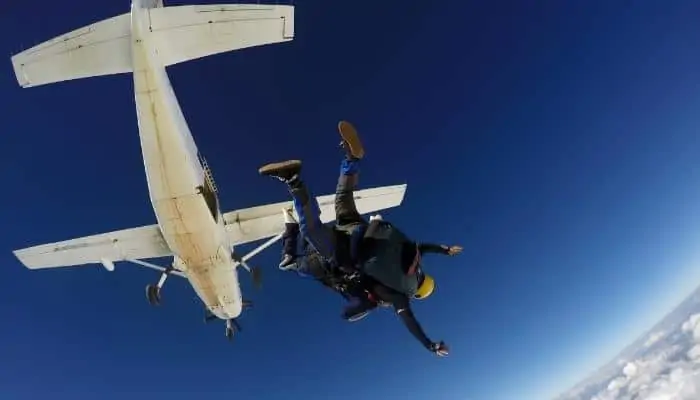Should You Let Your Child Try Extreme Sports?

This post may contain affiliate links. If you buy through the link, I may earn a commission. Learn More.
There are two schools of thought when it comes to extreme sports.
Some parents think children need to test their limits so their brains can properly develop. Others believe those brains need to be protected.
Neither group is wrong. Children need to learn, but they also need to survive.
*FYI, some of the links in this article about should you let your child try extreme sports may be affiliate links. If you click and make a purchase, we may get a commission (at no extra cost to you). For more info, please see our disclaimer.
Should You Let Your Child Try Extreme Sports?
If you think it’s appropriate and you’re willing to deal with any injuries that may happen, then you could consider letting your child do extreme sports with proper safety precautions. Make sure you understand that extreme sports can have a high rate of injury.
Pro-Tips!
Don’t let your child make this decision alone. Children think they’re invincible. They don’t have the healthy fear of accidents that adults develop over time.
They need to be safeguarded against some of their less healthy impulses, but some extreme sports are reasonable. Help your child make good choices as they test their limits.
Furthermore!
As you read through the rest of this article, I need you to keep in mind that as a parent, it’s ultimately your decision and NOT your kids.
After researching that specific sport, you, as the parent, will have to be okay with what all that sport entails.
You have to be okay with any injuries (severe or minor injuries) that may happen because, ultimately, it will also be your burden to bear both emotionally and financially.
Understanding What Extreme Sports Are

My favorite game as a child was one that I called “Demolition Derby.”
The basic concept was that I would ride my bike headfirst into a tree as hard as I could. I never claimed to be the smartest child, but I doubt I was the only kid making up my own extreme sports.
Today’s children have more options at their disposal. As parents, should we let them try these extreme sports, or should we protect them from themselves at all costs?
Before we make a decision about extreme sports, we need to understand what they are and why children find them so fascinating.
What are Extreme Sports
Extreme sports are sports with a significant risk for injury. While all sports have risks, extreme sports are based on the idea that the speed, height, or special skills involved make the sport very dangerous and more exciting. The thrill doesn’t come from playing the sport but from surviving it.
Examples of extreme sports include street luge, volcano surfing, cave diving, extreme pogo, bungee jumping, and extreme ironing.
Other extreme sports that are more common while including the danger factor are windsurfing, water skiing, rock climbing, and kayaking, among many others.
Why Are Kids Interested in Extreme Sports?
Children gravitate toward extreme sports for many reasons. A young person’s brain has a natural desire to take risks. The brain expands as children allow themselves to stretch beyond what is comfortable as they explore the world around them.
Another idea that has long been popular is that children don’t have fully developed frontal lobes.
The lack of brain development can lead to poor willpower, impulsivity, and recklessness. The frontal lobe doesn’t fully develop until around age 25.
Related: Should Parents Make Their Child Play Sports?
Benefits of Extreme Sports
- Increaseed Focus
- Better Grades
- Management of Fear
- Improving Self-Confidence
- Great Source of Excercise
There have even been studies that show extreme sports can increase focus, leading to better grades and a greater understanding of the world as a whole.
Along with that, extreme sports can help your child learn how to manage their fear, help boost their self-confidence and be a great source of exercise.
Alternatives to Extreme Sports
Some extreme sports are less extreme than others. Zorbing, the act of rolling down a hill in a transparent ball, is easily modified for even very young children.
Mountain biking can be done on rugged terrain without the height one might associate with mountains.
Skateboarding is somewhat safe as long as children wear the proper padding and helmet.
Kayaking is only dangerous in treacherous waters when no one is watching to ensure the child doesn’t capsize and risk drowning.
Slacklining can remain low to the ground, making it accessible to all.

Children with an interest in extreme sports might benefit from other, lower-risk activities.
Team sports are just as exciting as most extreme sports. Football, basketball, baseball, soccer, and volleyball all have the added bonus of socialization and camaraderie.
Children who show interest in extreme sports because they want something outside of mainstream sports might try karate or lacrosse.
What Will You Do?
Children can engage in some extreme sports with the right safety precautions.
Parents need to let their children explore in a secure manner. It may take some negotiation, but you and your child will eventually agree on a sport worth pursuing.
What do you think? Tell us in the comments.
Have You Read These Yet?
- How Much Freedom Should You Give Your Child?
- Should You Let Your Child Wear Makeup?
- Should I Let My Teen Become a Model?
